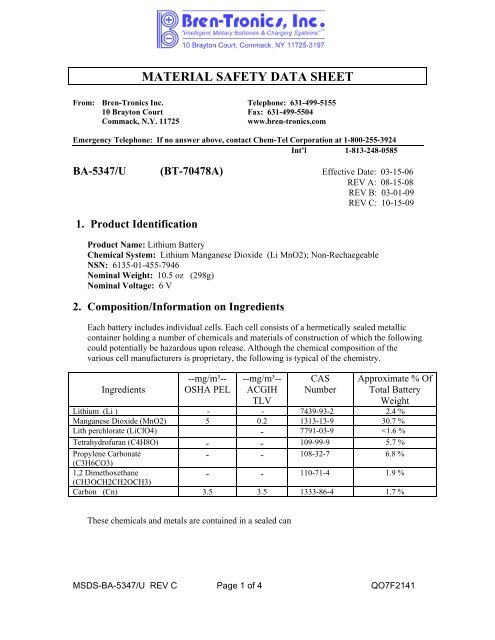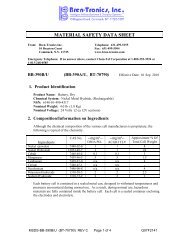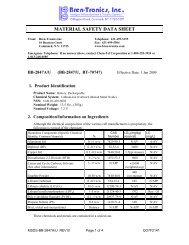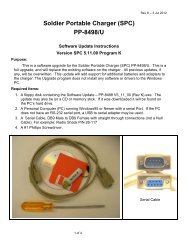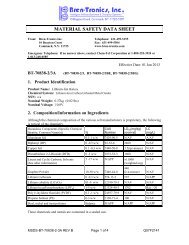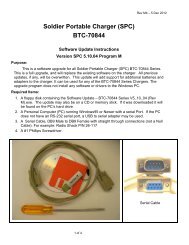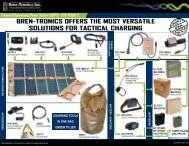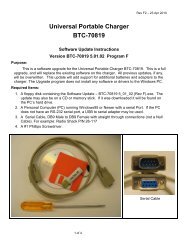MSDS - Bren-Tronics
MSDS - Bren-Tronics
MSDS - Bren-Tronics
You also want an ePaper? Increase the reach of your titles
YUMPU automatically turns print PDFs into web optimized ePapers that Google loves.
MATERIAL SAFETY DATA SHEET<br />
From: <strong>Bren</strong>-<strong>Tronics</strong> Inc. Telephone: 631-499-5155<br />
10 Brayton Court Fax: 631-499-5504<br />
Commack, N.Y. 11725<br />
www.bren-tronics.com<br />
Emergency Telephone: If no answer above, contact Chem-Tel Corporation at 1-800-255-3924<br />
Int’l 1-813-248-0585<br />
BA-5347/U (BT-70478A) Effective Date: 03-15-06<br />
REV A: 08-15-08<br />
REV B: 03-01-09<br />
REV C: 10-15-09<br />
1. Product Identification<br />
Product Name: Lithium Battery<br />
Chemical System: Lithium Manganese Dioxide (Li MnO2); Non-Rechaegeable<br />
NSN: 6135-01-455-7946<br />
Nominal Weight: 10.5 oz (298g)<br />
Nominal Voltage: 6 V<br />
2. Composition/Information on Ingredients<br />
Each battery includes individual cells. Each cell consists of a hermetically sealed metallic<br />
container holding a number of chemicals and materials of construction of which the following<br />
could potentially be hazardous upon release. Although the chemical composition of the<br />
various cell manufacturers is proprietary, the following is typical of the chemistry.<br />
Ingredients<br />
--mg/m³--<br />
OSHA PEL<br />
--mg/m³--<br />
ACGIH<br />
TLV<br />
CAS<br />
Number<br />
Approximate % Of<br />
Total Battery<br />
Weight<br />
Lithium (Li ) - - 7439-93-2 2.4 %<br />
Manganese Dioxide (MnO2) 5 0.2 1313-13-9 30.7 %<br />
Lith perchlorate (LiClO4) - 7791-03-9
3. Hazards Identification<br />
Do not short circuit, recharge, puncture, incinerate, crush, immerse, force discharge, or expose to temperatures above<br />
85 C as there is risk of fire or explosion if doing so. This Lithium Manganese Dioxide battery contains sealed units<br />
which are not hazardous when used according to manufacturers recommendations.<br />
Under normal conditions of use, the electrode materials and electrolyte they contain are not exposed to the outside,<br />
provided the battery integrity is maintained and seals remain intact. Risk of exposure is only in case of abuse<br />
(mechanical, thermal, electrical) which leads to the activation of safety valves and/or rupture of the cell containers.<br />
Electrolyte leakage or battery vent /explosion /fire may follow, depending upon the circumstances.<br />
4. First Aid Measures<br />
Inhalation- Remove from exposure; rest and keep warm. In severe cases obtain medical attention.<br />
Skin Contact- Wash off skin thoroughly with tap water. Remove contaminated clothing and wash<br />
before reuse. In severe cases obtain medical attention.<br />
Eye Contact- Irrigate thoroughly with water for at least 15 minutes. Obtain medical attention.<br />
Ingestion- Wash out mouth thoroughly with water and give plenty of water to drink. Obtain medical<br />
attention.<br />
Further Treatment- All cases of eye contamination, persistent skin irritation and casualties who<br />
have swallowed any of this substance or been affected by breathing its<br />
vapors should see a doctor.<br />
5. Fire Fighting Measures<br />
Extinguishing Media: Use water or CO2 on burning cartons or batteries and intact cells.<br />
Special Fire Fighting Procedures:<br />
Cool fire-exposed batteries and adjacent structures with water spray from a distance.<br />
CO2 extinguishers or copious quantities of water or water based foam can be used to cool down burning<br />
batteries and cells as long as the extent of the fire has NOT progressed to the point that the lithium metal that<br />
they contain is exposed. For the general cool down do not use sand, dry powder, soda ash, graphite powder<br />
or fire blankets.<br />
Use only metal (Class D) extinguishers on raw lithium.<br />
6. Accidental Release Measures<br />
Ventilation: None under normal use conditions.<br />
Protective Gloves: None under normal use conditions. Use butyl gloves when handling leaking<br />
batteries.<br />
Eye Protection: None under normal use conditions. Wear safety glasses when handling leaking batteries.<br />
Earth or sand may be used to absorb any exudation. Seal leaking battery and earth in a heavy duty<br />
polyethylene bag and dispose of as special waste in accordance with local regulations.<br />
7. Handling and Storage<br />
Precautions to be taken in Handling and Storage:<br />
Do not short circuit, recharge, force discharge, immerse, puncture or crush.<br />
<strong>MSDS</strong>-BA-5347/U REV C Page 2 of 4 QO7F2141
Store batteries in a cool , dry area that is subject to little temperature changes. Prevent condensation on<br />
batteries. Do not place near heating equipment, nor expose to direct sunlight for long periods. Elevated<br />
temperatures can result in reduced battery service life.<br />
Other Precautions: applying pressure or deforming battery may lead to dis-assembly.<br />
8. Exposure Controls/Personal Protection<br />
Steps to be taken in Case Material is Released or Spilled:<br />
Notify safety personnel of large spills. Evacuate the area and allow vapors to dissipate.<br />
Increase ventilation. Avoid eye or skin contact. DO NOT inhale vapors. Clean up personnel should wear<br />
appropriate protective gear. Remove spilled liquid with absorbent and contain for disposal.<br />
In large fire situations, use self-contained breathing apparatus.<br />
9. Physical and Chemical Properties<br />
Appearance<br />
Odor<br />
Rectangular shape<br />
If leaking, smells of medical ether<br />
10. Stability and Reactivity<br />
Stability:<br />
Stable<br />
Conditions to Avoid:<br />
Do not heat, crush, disassemble, short-circuit or recharge.<br />
Hazardous Decomposition or By-products:<br />
Thermal degradation may produce hazardous fumes of manganese and lithium; Hydrofluoric acid; oxides of<br />
carbon and sulfur and other toxic by-products. Lithium metal reacts with water to produce highly flammable<br />
gases.<br />
Hazardous Polymerization:<br />
Will not occur.<br />
Incompatible Materials:<br />
Contents incompatible with strong oxidizing agents, alkalis, water.<br />
11. Toxicological Information<br />
Signs and symptoms- None, unless battery ruptures. In the event of exposure to internal contents, vapor fumes may be<br />
irritating to the eyes and skin. Inhalation- Lung irritant; Skin Contact- Skin irritant, Eye Contact- Eye irritant<br />
Ingestion- Poisoning if swallowed, Target organs- nerves, liver snd kidneys.<br />
12. Ecological Information N/A<br />
13. Disposal Considerations<br />
Waste Disposal Method:<br />
No special precautions are required for small quantities. Large quantities of open batteries should be treated<br />
as hazardous waste. Dispose in accordance with local, state, and federal regulations. Do not incinerate,<br />
since batteries may explode at excessive temperatures.<br />
<strong>MSDS</strong>-BA-5347/U REV C Page 3 of 4 QO7F2141
14. Transport Information<br />
Transportation: The Lithium metal content per battery is 7.2g (3.6g/cell). The battery and component cells have<br />
been tested and found to conform to UN T1-T8 test requirements. The battery must be transported according to<br />
the following regulations:<br />
Domestic Transportation within the U.S./ 49 CFR Section 173.185:<br />
Via ground only (motor vehicle, rail):<br />
Excepted battery, no special packaging required other than: For quantities 13 and larger in one box, use label<br />
“LITHIUM METAL BATTERY" on the box (shown below). Waybill document to also indicate procedures<br />
should be followed if package is damaged . Maximum gross weight of the package is 30kg (66lbs) and the<br />
package must be capable of being dropped 1.2 meters in any orientation without causing battery short circuits<br />
and without release of package contents.<br />
The box is to carry additional label: “LITHIUM BATTERIES - FORBIDDEN FOR TRANSPORT<br />
ABOARD AIRCRAFT AND VESSEL” (with letters 0.5” ht minimum).<br />
Via air or cargo vessel:<br />
Batteries must be shipped as Class 9 Dangerous Goods with required UN specification packaging, labels,<br />
marking, shipper’s declaration for dangerous goods, and emergency response information. Batteries conform to<br />
UN T1-T8 test requirements. Proper shipping classification is UN 3090, Lithium Metal Batteries, Class 9,<br />
Packing Group II.. Maximum gross weight of the package is 35kg (77lbs) for air transport; no limit for vessel.<br />
Classification for batteries packed with or packed in equipment is UN 3091<br />
International Transportation: ADR, IMDG Code, IATA Dangerous Goods Regulations:<br />
Batteries must be shipped as Class 9 Dangerous Goods with required UN specification packaging, labels,<br />
marking, shipper’s declaration for dangerous goods, and emergency response information. Batteries conform to<br />
UN T1-T8 test requirements. Proper shipping classification is UN 3090, Lithium Metal Batteries, Class 9,<br />
Packing Group II. Maximum gross weight of the package is 35kg (77lbs) for air transport; no limit for vessel.<br />
Classification for batteries packed with or packed in equipment is UN 3091. Any person preparing or offering<br />
batteries for transport must receive adequate instructions commensurate with their responsibilities.<br />
15. Regulatory Information<br />
Batteries are considered to be “articles” and thus are exempt from TSCA regulation.<br />
16. Other Information<br />
Avoid mechanical or electrical abuse. DO NOT short circuit or install incorrectly. Batteries may explode,<br />
pyrolize or vent if disassembled, crushed, recharged incorrectly or exposed to high temperatures. Install<br />
batteries in accordance with equipment instructions.<br />
_____________________________________________________________________________________<br />
This information and recommendations set forth are made in good faith and believed to be accurate as of the date of<br />
preparation. <strong>Bren</strong>-<strong>Tronics</strong> Inc. makes no warranty, expressed or implied, regarding the accuracy of the data or the<br />
results to be obtained from the use thereof.<br />
<strong>MSDS</strong>-BA-5347/U REV C Page 4 of 4 QO7F2141


